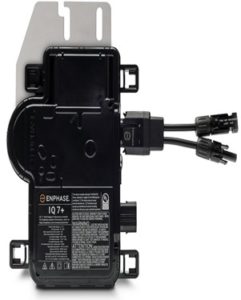California homeowners have several options to choose from when selecting their home solar inverter. The two dominant players in the residential marketplace today are SolarEdge (central inverter with DC optimizers) and Enphase (micro inverters). Most California home solar installers use SolarEdge as it is more competitive. Both have pros and cons and I discuss them in more detail here.
Central inverter: A single inverter connects your entire array of solar panels to your electrical panel. Central inverters are the least expensive inverter option and cost less than micro-inverters. However, if one of the solar panels stops producing electricity, even due to temporary shading, it can bring down the performance of the entire system. Central inverters were extremely popular in the industry back in 2010; but modern technologies have made them almost obsolete in residential installations. Central inverters are warrantied by the manufacturer for 12 years.
Micro-inverters: With a micro-inverter system, one micro inverter is installed behind each solar panel, which allows each solar panel to maximize energy production. If some of your solar panels are shaded at different times of the day or if they aren’t all installed facing the same direction, micro-inverters will minimize performance issues. The cost of micro-inverters is typically higher than the cost of central inverters. Micro inverters are warrantied by the manufacturer for 25 years.
Power optimizers: Home solar systems that use power optimizers are a hybrid of micro-inverter and central inverter systems. Like micro-inverters, power optimizers are installed behind each panel. However, instead of converting the DC electricity from the solar panels into AC electricity, the optimizers “condition” the DC electricity before sending it to the centralized inverter. Like micro-inverters, they perform well when one or more panels is shaded or if panels are installed facing different directions. Power optimizer systems tend to cost more than central inverter systems, but less than micro-inverter systems. Power optimizers are warrantied by the manufacturer for 25 years.
After years of experience working on California home solar projects with both Enphase and SolarEdge home solar inverters, I decided to exclusively work with Enphase two years ago. The reason for this decision is that we were seeing SolarEdge central inverters fail in the field, and without proper monitoring by the homeowner this would cause the potential for large annual true up bills from the electric utility due to the entire system being down for an extended period (single point of failure). With an Enphase micro inverter system, even if one or two micro inverters fails, the rest of the system will continue to produce energy (no single point of failure).
We exclusively recommend Enphase Micro Inverters on home solar projects!
One final thing to note about home solar inverters. If you are installing a home solar battery with your home solar inverter you will need to pair the home solar inverter with the home solar battery. For example, an AC coupled system (Enphase) can only pair with an AC battery (Enphase or Tesla), and a DC coupled system (SolarEdge) can only pair with a DC battery (SolarEdge).
Want to see how much money you can save with a home solar panel and solar battery system? Get your turnkey California home solar panel and solar battery proposal with ROI and financing options by e-mailing us your most recent electric bill (all pages), a picture of the electrical panel outside your home, and a picture of your roof material today: info@beachcitiessolarconsulting.com


